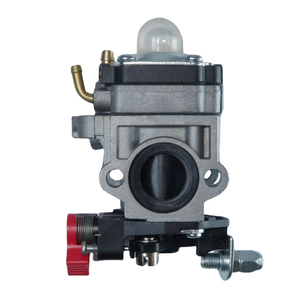(229 products available)































































































































































































As an integral component of some equipment, the 33cc engine comes in various types, each suitable for different applications.
The 33cc two-stroke engine features the conventional design of two-stroke engines, with separate intake and exhaust valves. It utilizes two strokes to complete an engine cycle: compression/ignition and exhaust/intake. In the compression/ignition stroke, the piston compresses the air-fuel mixture and ignites the mixture to produce power. Simultaneously, the exhaust and intake valves open and close to expel exhaust gases and allow a fresh air-fuel mixture into the combustion chamber. Two-stroke engines are usually lighter and more powerful than four-stroke engines of the same displacement. However, they consume more fuel and produce more emissions.
The 33cc four-stroke engine adopts the more modern four-stroke engine working principle. It completes an engine cycle in four strokes: intake, compression, power, and exhaust. During the intake stroke, the piston moves down, allowing the air-fuel mixture to enter the combustion chamber. The mixture is then compressed during the compression stroke. The mixture is ignited during the power stroke, generating power. Finally, the exhaust valve opens, and the piston moves up, expelling the exhaust gases. Four-stroke engines are more fuel-efficient and produce fewer emissions than their two-stroke counterparts. They are also more durable and have a longer service life.
These engines have more than one cylinder. Each cylinder is an individual engine that works independently. Adding more cylinders can increase the engine's displacement and power output. Multi-cylinder engines run more smoothly and have less vibration than single-cylinder engines. They are also more powerful and efficient. However, they are more complicated and require more maintenance.
These engines use the wind produced by the cylinder movement to cool down. Air-cooled engines are lighter and more straightforward than water-cooled engines. However, they are not as effective at regulating temperature and are more likely to overheat.
The electric 33cc engine is powered by electricity and is suitable for machines that require quiet operation. The electric engine produces less noise than the combustion engine.
Specification
Displacement: The displacement of a 33cc small engine is 33 cubic centimeters, which indicates the total volume of air/fuel mixture the engine can burn in a single cycle.
Power output: The power output of a 33cc engine is generally around 0.9-1.2 kilowatts (kW) or horsepower (HP). The specific power output may vary depending on the design and application of the engine.
Fuel system: A 33cc engine is usually equipped with a carburetor or fuel injection system to precisely mix and deliver fuel and air to the combustion chamber.
Ignition system: The ignition system of a 33cc engine is typically composed of a spark plug, ignition coil, and flywheel, which work together to ignite the air/fuel mixture and initiate the combustion process.
Exhaust system: The exhaust system of a 33cc engine includes the exhaust manifold, muffler, and exhaust pipe, which are responsible for guiding and reducing the noise of the high-temperature gases produced during the engine's operation.
Cooling system: A 33cc engine may adopt an air-cooled or liquid-cooled design to regulate the operating temperature of the engine and prevent overheating.
Lubrication system: The lubrication system of a 33cc engine consists of an oil pump, oil filter, and lubricant, which are responsible for lubricating and reducing friction among the engine's internal components.
Starter: A 33cc engine is generally equipped with a recoil starter or electric starter to initiate the engine's operation.
Regular maintenance and proper care are crucial for ensuring the optimal performance and longevity of the 33cc engine.
Here are some maintenance tips for the 33cc engine:
Engines with a 33cc displacement are used in many applications. Here are some common uses of the 33cc engine in various products.
When looking for a 33cc 2-stroke engine for sale, buyers should consider the following factors.
Investing in a quality, sturdy engine is important for long-term use and low maintenance costs. Look for engines with solid metal parts that are less likely to wear out quickly or break. The engine should also have a tough exterior that can resist damage.
Consider the engine's power rating to ensure it's suitable for the intended application. Engines with more power are better for demanding tasks. If unsure about the power needed, consult with a supplier who can recommend the appropriate power rating.
Consider the engine's technology to see if it has desirable features like low emissions, low noise, or fuel efficiency. Some engines have designs that reduce the amount of fuel they use, which can save money in the long run.
Some manufacturers are more trusted than others because they consistently produce high-quality engines. Research the brand to see if it has positive or negative reviews. If possible, get an engine from a manufacturer with a strong warranty.
Q1: What is the most powerful 33cc chainsaw?
A1: Some of the most powerful chainsaws with a 33cc engine are the Hitachi CS33EDTP, the Tanaka TCS33EDTP, and the Echo CS-4510. These models have different features and specifications that vary in terms of performance, weight, and cutting capacity. Business buyers should compare them to choose the best one for their needs.
Q2: How much power does a 33cc engine have?
A2: The power of a 33cc engine varies according to its design and application. In general terms, a 33cc two-stroke engine with a power output of 1.2kW (1.6HP) at 2000-8000 rpm is suitable for chainsaws, brush cutters, and agricultural machinery. Meanwhile, a 33cc four-stroke engine can deliver a higher torque range and better fuel efficiency.
Q3: Can 33cc engine oil be used for 2-stroke?
A3: No, a 33cc engine oil should not be used for 2-stroke engines. Two-stroke engines require the use of special oil that mixes with the fuel. Using improper oil can damage the engine and affect its performance. It is always better to use two-stroke or multi-stroke oil.